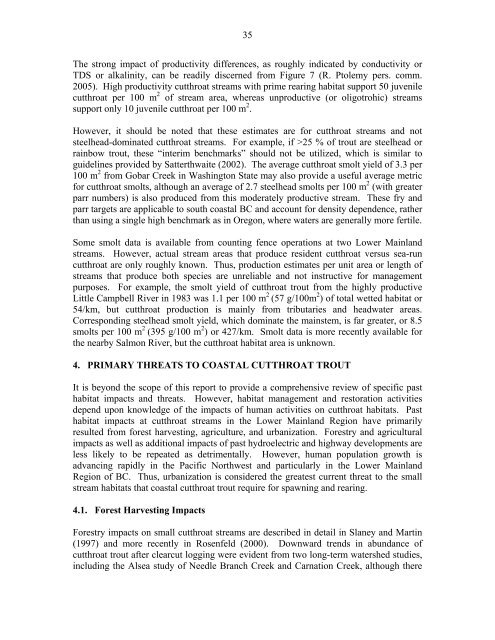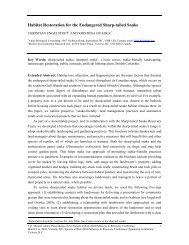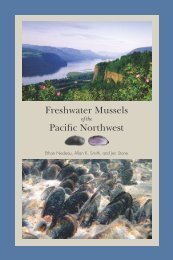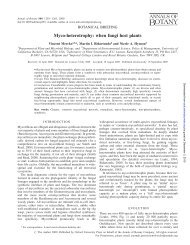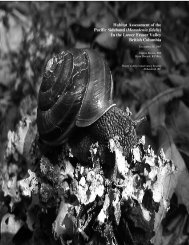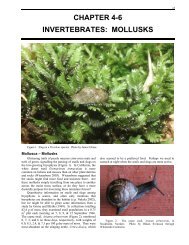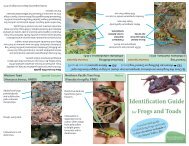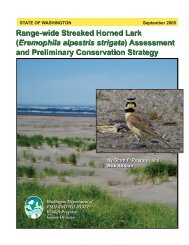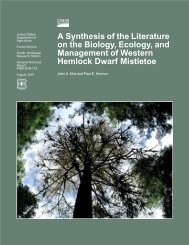Coastal Cutthroat Trout as Sentinels of Lower Mainland Watershed ...
Coastal Cutthroat Trout as Sentinels of Lower Mainland Watershed ...
Coastal Cutthroat Trout as Sentinels of Lower Mainland Watershed ...
You also want an ePaper? Increase the reach of your titles
YUMPU automatically turns print PDFs into web optimized ePapers that Google loves.
35The strong impact <strong>of</strong> productivity differences, <strong>as</strong> roughly indicated by conductivity orTDS or alkalinity, can be readily discerned from Figure 7 (R. Ptolemy pers. comm.2005). High productivity cutthroat streams with prime rearing habitat support 50 juvenilecutthroat per 100 m 2 <strong>of</strong> stream area, where<strong>as</strong> unproductive (or oligotrohic) streamssupport only 10 juvenile cutthroat per 100 m 2 .However, it should be noted that these estimates are for cutthroat streams and notsteelhead-dominated cutthroat streams. For example, if >25 % <strong>of</strong> trout are steelhead orrainbow trout, these “interim benchmarks” should not be utilized, which is similar toguidelines provided by Satterthwaite (2002). The average cutthroat smolt yield <strong>of</strong> 3.3 per100 m 2 from Gobar Creek in W<strong>as</strong>hington State may also provide a useful average metricfor cutthroat smolts, although an average <strong>of</strong> 2.7 steelhead smolts per 100 m 2 (with greaterparr numbers) is also produced from this moderately productive stream. These fry andparr targets are applicable to south co<strong>as</strong>tal BC and account for density dependence, ratherthan using a single high benchmark <strong>as</strong> in Oregon, where waters are generally more fertile.Some smolt data is available from counting fence operations at two <strong>Lower</strong> <strong>Mainland</strong>streams. However, actual stream are<strong>as</strong> that produce resident cutthroat versus sea-runcutthroat are only roughly known. Thus, production estimates per unit area or length <strong>of</strong>streams that produce both species are unreliable and not instructive for managementpurposes. For example, the smolt yield <strong>of</strong> cutthroat trout from the highly productiveLittle Campbell River in 1983 w<strong>as</strong> 1.1 per 100 m 2 (57 g/100m 2 ) <strong>of</strong> total wetted habitat or54/km, but cutthroat production is mainly from tributaries and headwater are<strong>as</strong>.Corresponding steelhead smolt yield, which dominate the mainstem, is far greater, or 8.5smolts per 100 m 2 (395 g/100 m 2 ) or 427/km. Smolt data is more recently available forthe nearby Salmon River, but the cutthroat habitat area is unknown.4. PRIMARY THREATS TO COASTAL CUTTHROAT TROUTIt is beyond the scope <strong>of</strong> this report to provide a comprehensive review <strong>of</strong> specific p<strong>as</strong>thabitat impacts and threats. However, habitat management and restoration activitiesdepend upon knowledge <strong>of</strong> the impacts <strong>of</strong> human activities on cutthroat habitats. P<strong>as</strong>thabitat impacts at cutthroat streams in the <strong>Lower</strong> <strong>Mainland</strong> Region have primarilyresulted from forest harvesting, agriculture, and urbanization. Forestry and agriculturalimpacts <strong>as</strong> well <strong>as</strong> additional impacts <strong>of</strong> p<strong>as</strong>t hydroelectric and highway developments areless likely to be repeated <strong>as</strong> detrimentally. However, human population growth isadvancing rapidly in the Pacific Northwest and particularly in the <strong>Lower</strong> <strong>Mainland</strong>Region <strong>of</strong> BC. Thus, urbanization is considered the greatest current threat to the smallstream habitats that co<strong>as</strong>tal cutthroat trout require for spawning and rearing.4.1. Forest Harvesting ImpactsForestry impacts on small cutthroat streams are described in detail in Slaney and Martin(1997) and more recently in Rosenfeld (2000). Downward trends in abundance <strong>of</strong>cutthroat trout after clearcut logging were evident from two long-term watershed studies,including the Alsea study <strong>of</strong> Needle Branch Creek and Carnation Creek, although there


